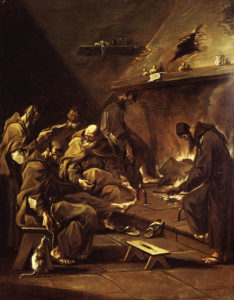Object of the Month: March 2015
Monks before a Fireplace
Oil on canvas
Alessandro Magnasco, called Il Lissandrino
Genoese, 1667–1749
Click on the links throughout the article to view additional artists’ works and reference material.
No matter the era or the medium, it seems you can always count on artists to challenge the status quo.
Alessandro Magnasco was born in Genoa, northern Italy, in 1667. His father Stefano was a minor artist who died when Magnasco was only five years old. Around the age of ten, Magnasco was sent to Milan to live under the care of a patron while he learned commerce. However, his interests lay along the same lines as his father’s, and before long he had convinced his patron to sponsor an apprenticeship for him with the renowned Mannerist painter, Filippo Abbiati, of Milan. By 1690, Magnasco had mastered his craft and had established himself as a portraitist. This phase of his career lasted only a brief time before he transitioned into his distinguished, celebrated style.
Magnasco’s style is something of an anomaly, even for the eclectic movement that is the Baroque. His is a nervous, loose brushwork that conveys fluid movement and hazy figures and settings. Murky tones pervade his paintings, with the occasional pockets of stark light and strong color. Arguably his most interesting characteristic is his choice of unusual subject matter.
In a time largely characterized by paintings of religious subject matter, Magnasco chose instead to focus on the common man, such as beggars and gypsies, and on some of the more obscure facets of contemporary life, such as shadowy synagogue interiors and scenes of monastic life. Interestingly, Magnasco also often chose to portray scenes charged with social commentary, going even so far as to treat highly controversial subjects—in his day as well as our own—as in his painting of an Inquisition torture scene. Magnasco seemed captivated by the mysterious, socially questionable, and the bizarre.
Monks before a Fireplace is characteristic of Magnasco’s mature style. His elongated figures are reminiscent of the mannerist El Greco. At the same time, his monochromatic palate and mysterious, almost ghoulish, atmosphere heralds the coming of nineteenth-century realist Francisco Goya. Here, Magnasco once again presents the common man in his paintings—humble monks instead of otherworldly saints. His figures possess a uniformity, functioning almost as a nameless, faceless unit. But on closer examination, the figures are strikingly distinct, suggesting the idiosyncrasies of the individuals within the group including the monk perusing his crinkled manuscript and the man warming his feet at the fire while toying with the resident cat. He captures a snapshot of a quiet moment in contemporary monastic life.
Indeed, Magnasco’s very essence seems almost out of place in his world, a nod to modernism from the late baroque era.
Katharine Golighty, former Docent & Guest Services Attendant
Published in 2015
